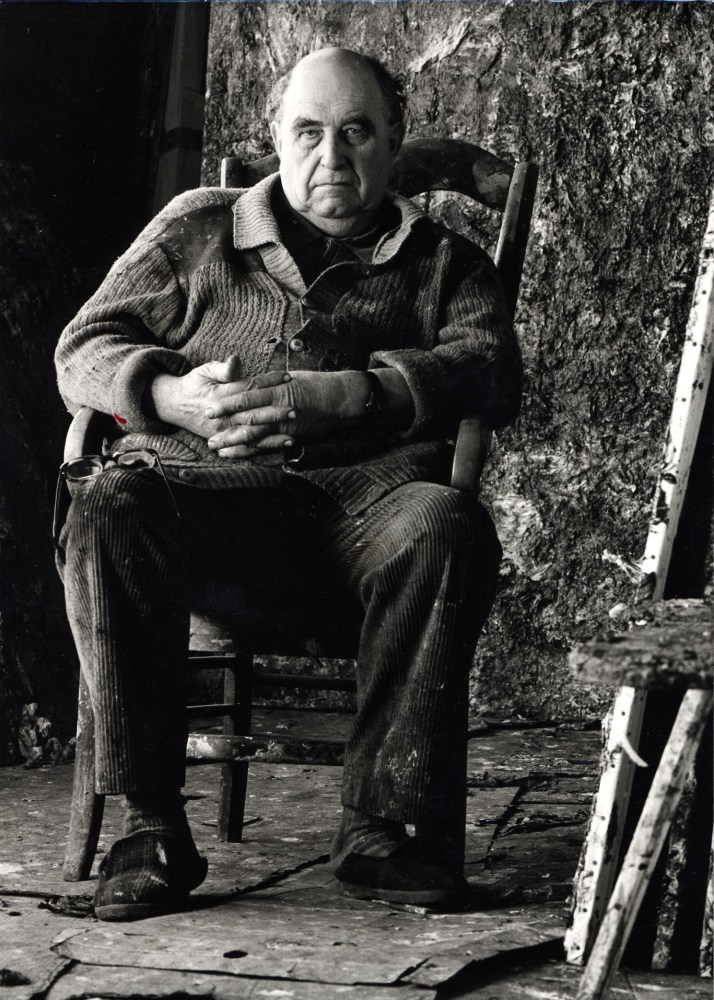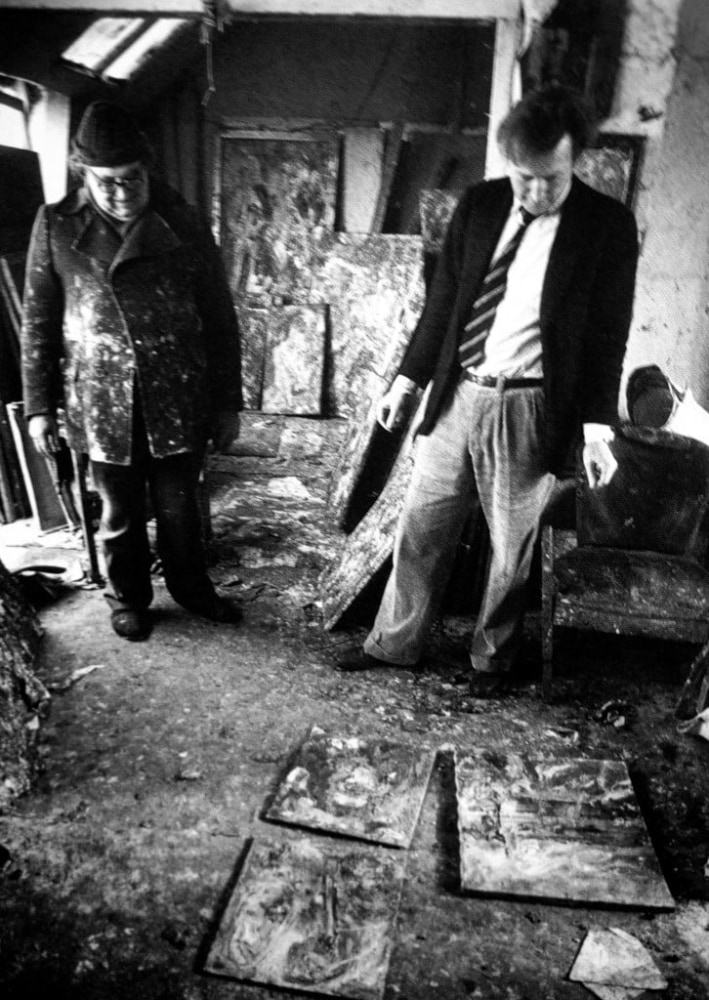
Eugène Leroy in his studio
Thirty-four years after the exhibition at the Musée d'Art Moderne de Paris, which introduced Eugène Leroy (1910-2000) to the French public, his works are once again on display there, in a retrospective on view through 28 August 2022.
Born in 1910 in Tourcoing in northern France, near the Belgian border, Eugène Leroy is one of the greatest French painters of the second half of the 20th Century. Influenced by the likes of Rembrandt and Jean Fautrier, he was a challenging, extraordinary artist who upended traditional practices with keen sculptural insight and a masterful command of light. His paintings, are experimental, craggy, gnarled surfaces, thickly layered with oil impasto, and are meant to engage viewers with a sensual, new mode of viewing. Although traditional in content, often depicting still-lifes and nudes, Leroy’s work urges viewers to look anew at the substance and materiality of his compositions and see how they engage with their environs.
In 1931 Leroy studied at the School of Fine Arts in Lille and studied drawing in Paris. His first exhibition took place in 1937 in Lille. His exhibited paintings were influenced by Rembrandt’s Jewish Bride at the Rijksmuseum in Amsterdam and by paintings by Malevich. He exhibited steadily throughout France over the next forty years with the support of the critic Gaston Diehl and the dealer Pierre Leon, among others.
In 1961, a young Georg Baselitz saw Leroy’s work in Paris. He became one of Leroy’s most significant admirers, and saw in his paintings ‘a totally new phenomenon’: “In his work, I found images that were as brown as the fields, as stone, as wood, as moss, as fragrance. …an incredible accumulation of colour… As if all the painter’s trousers were hanging from a single hook and telling the story of an unknown masterpiece.”
After years of support from Baselitz and Michael Werner, Galerie Michael Werner began to represent Leroy in the early 1980s. Leroy’s first exhibition with Michael Werner was in Cologne in 1983. The gallery has shown his work worldwide ever since. Works by Leroy are found in major American and European collections and have been featured in exhibitions at the Albright-Knox Art Gallery, Buffalo, New York; The Power Plant, Toronto; Van Abbemuseum, Eindhoven; Museum van Hedendaagse Kunst, Gent; Musée d'Art moderne de la Ville de Paris; Musée d'Art moderne et d'Art contemporain, Nice; Sao Paulo Bienal, Brazil; and Documenta IX, Kassel. Leroy died in 2000 in Wasquehal, a suburb of Lille.

Eugène Leroy in his studio with Michael Werner
“With Leroy, on the other hand, the incredible matterism of his paintings, does not make his landscapes particularly “tormented,” nor his character’s “monstrous,” nor even “proud” or “ashamed” to show themselves naked, I would go so far as to say that Leroy’s landscapes and nudes, assuming we are able to identify them, exude an unexpected serenity. (…) Of course, Leroy too has his arsenal of mastered effects. But although the effects are recognizable at first glance, it is not so easy to identify the process that produced them. Leroy’s pictorial art art is therefore no less novel than Fautrier’s, it is only more ineffable, that is to say more durably new. Our understanding of oil painting, which some believe has already been exhaustively explored, is thereby enriched by an unexpected mystery.” – Hector Obalk
Through more than seven decades of devotion to painting, Eugène Leroy remained passionately committed to a personal interpretation of the classic genres of high art: still-lifes, landscapes and nudes. The female figure in particular was a constant source of inspiration and challenge for the artist. As he stated in a 1992 interview, "Creating a figure...and imparting life to it - this level of art belongs most properly to painting." Emerging radiant from thick layers of paint or lurking, barely discernible amidst peaks and crevices of color, Leroy's nudes appear to be sculpted from the paint itself. Indeed, the materiality of the artist's pigment is often the most immediate and recognizable characteristic of a Leroy painting. Paradoxically, Leroy's lifelong obsession was not with matter but with light: the density of Leroy's painting lends an oddly porous quality to his subjects, enhancing the shimmering luminosity which suffuses his canvases. Leroy's ultimate achievement in painting was to reconcile the physical matter of pigment with the potential of ephemeral light.
In a letter, the artist describes his work and its placement amidst the canon of art history: “The field of vision of the painting was delivered from the image that even Cézanne and Rembrandt have given us, if we do not put them back into their incisive truth; this reduction I think is painting itself. And it’s to get back to myself that I speak of it…. For me it’s taking the years past, on the same canvas as I have done, by accumulation, scraping off, adding, going back and forth between that which comes and does not come.”
In a review from the New York Times, art critic Roberta Smith discusses “Mr. Leroy’s extravagantly paint-laden canvases” and relates his “sublime” work “to a long line of artists in love with the sheer physicality of paint, from Rembrandt and van Gogh to Chaim Soutine, Lovis Corinth, James Ensor, Jean Dubuffet and Willem de Kooning. (…) [They] are engrossing in the way a glowing, slow-burning log might be: they are mesmerizing in their flickering details of texture and color, and so impacted with paint that they almost seem to give off their own heat. It takes time actually to see them as paintings, and more time still to see them as different from one another. They seem at first more like geological formations -- or expanses of petrified moss or chaotic topographical maps -- than handmade artworks. But after a while, the deliberation with which their seemingly inchoate surfaces are composed begins to assert itself.”
In 1988, the Musée d’Art Moderne de la Ville de Paris held the first retrospective of Leroy’s work; the exhibition travelled to the Eindhoven Museum in the Netherlands. In 2003 a major donation of works by the artist was made to the Pompidou in Paris. In 2009, following a major donation of the archive and works of Leroy from the artist's estate, the fine arts museum of Tourcoing was renamed Musée des Beaux Arts Eugène Leroy de Tourcoing. Comprising several dozen paintings and over two hundred drawings and prints, as well as works from the collection of the artist, this collection fully documents the artist's activities from 1930 to 2000.